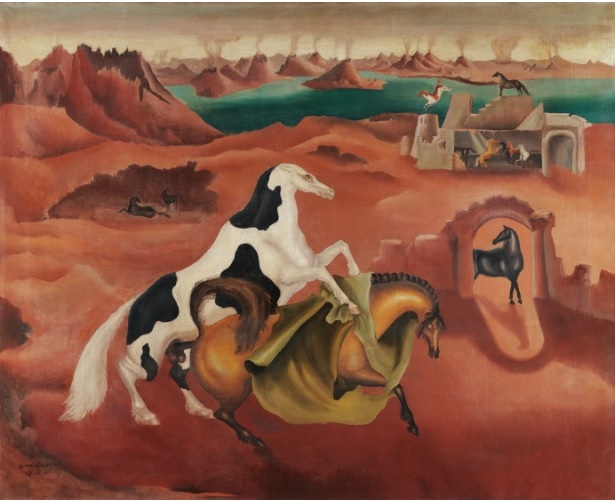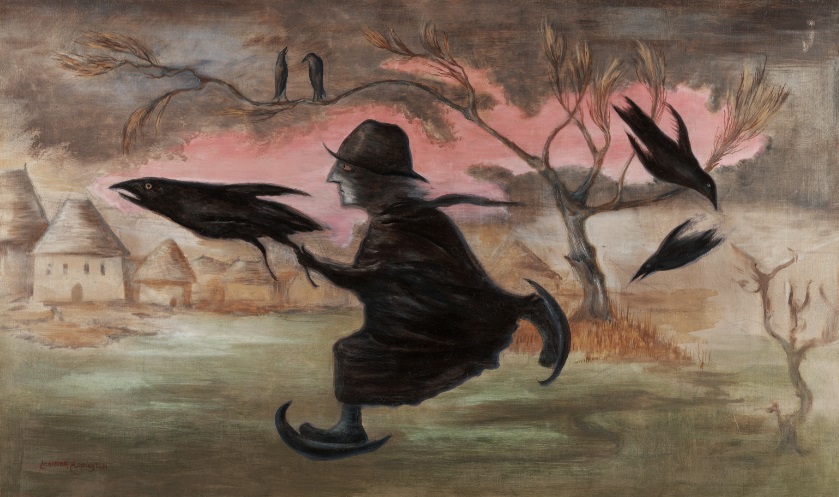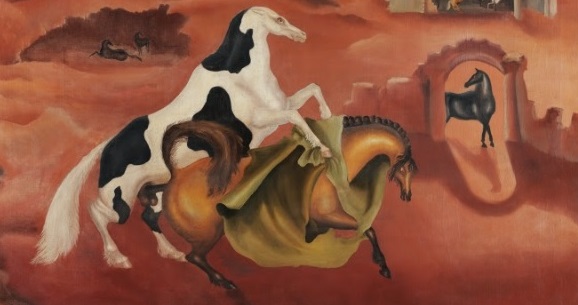British-born surrealist painter and novelist Leonora Carrington was rebellious by nature and inspired by fairy tales and fiction and did surrealistic painting and wrote whatever she wanted to be. Leonora Carrington was born into a wealthy family, her mother was of Irish descent, and she got familiar with Irish folklore and fairy tales through her mother. That fairy tale element flourished in her paintings, symbolising her rebellious life on the canvas with the weird performativity of animals.
Leonora was a bibliophile at a young age, and read as many books, mainly fairy tales and folk stories, that liberated herself from her upper-middle-class lifestyle. She started her creative career as a writer, creating those fairytales with imaginative ambience in her writings and continued with paintings. Leonora’s artworks always display the liberating, animated fairytale component typical of imagination. Her paintings, as art historian Jane Alison explained, ‘the surrealist house is a convulsive theatre of the domestic; both a real space and a metaphoric space, inhabited if not by the people, then by their ghosts, quoted by Claudette Lauzon in his essay, An Unhomely Genealogy of Contemporary Art.

“They say it’s not proper for girls to do the things boys do. I have three brothers. They can always do whatever they want just because they are boys. It’s not fair… When I grow up, I want to shave…” Leonora Carrington said, quoted in Google Art and Culture. This statement tells us why Leonora is rebellious and why the animals are present in her paintings. She understands the difference between real life and the imagination that brings the ultimate freedom to women’s life. Leonora started using the imaginative world’s performative approach to reproduce herself as a metaphor for free women. She symbolised herself as a rebellious, spirited and expelled fairy tale from the creative grounds.
Leonora stands against the social norms that make a barrier for women and gives freedom to men. In doing this, Leonora brings back the fairy tale ambience to her paintings, which liberate her into a wonderous world of women’s life. Leonora’s expulsion from the school is only the beginning of her rebellious life, and soon she leaves home to go to Paris to live and paint freely; gradually, she becomes part of a surrealist group and first participation in the International Surrealist Exhibition of 1938 in Paris change her life forever.

The meeting with Max Ernst is a life-changing experience for Leonora and engagement with the surrealist movement’s critical figure, which leads them to as a ‘surrealist couple’. She becomes increasingly into surrealist art, using metaphor and imageries liberated from reason and logic, a mixture of animalistic and hideous figures haunting her dreams. In Caballos (1941), Leonora uses erotic trials and anecdotes to reinterpret the non-existing fantasies and visual monologues. The wild instinct of animal life is intriguing and manifested in human life as a character or the hidden factor. For Leonora, what is human is a domestication of wild instincts. A human for the human characterises the horse and hyena; as Leonora said, “Each of us possesses an animal soul”.
‘I hoped these spasms would diminish my sorrow, which tore at my stomach like earthquakes. I know now that this was but one of the aspects of those vomitings: I had realised the injustice of society; I wanted, first of all, to cleanse myself and then go beyond its brutal ineptitude. My stomach was the seat of that society, but also the place in which I was united with all the elements of the earth. It was the mirror of the world, the reflection of which is just as honest as the person reflected, writes Leonora in her book Down Below. She wrote about the aftermath of Max Ernst being taken to a concentration camp for the second time, and she travels to Spain after being declared “incurably insane.”
Through the artwork, Leonora declared her solidarity with young people who try to live outside the social context and decline to surrender to its rules. In her surreal world, bloodshed and corpses and cannibalism is a common thing and shown as usual and legitimate acts. Through this visual action, Leonora questions the social norms constructed throughout the historical context.
The woman in The Crow Catcher (1990) carries the lineage of a fairy tale witch. She constantly questions the norms of society until her death; that link is reflected in this work as a visual language of an artist.
Life and artwork have never been different entities that resonate with the artistic practice. Why doing artwork is a subject of exploration, and Leonora did that in her canvas with her never-ending rebellious tender soul.
Feature Image and Source: Google Art and Culture

Krispin Joseph PX, a poet and journalist, completed an MFA in art history and visual studies at the University of Hyderabad.





